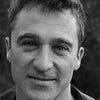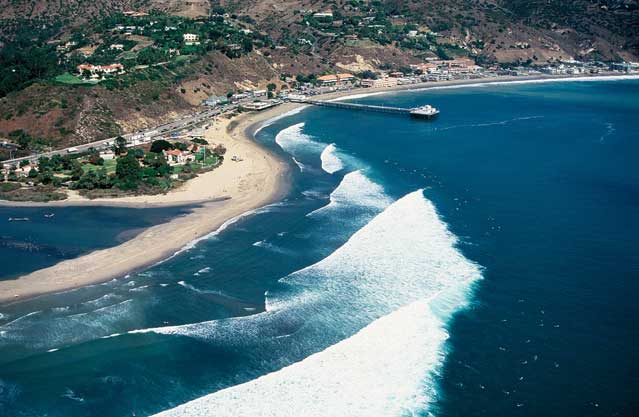Out in sun-kissed Malibu, birthplace of modern surf culture and part-time residence for Hollywood’s bankable faces, a strange environmental battle is raging. On one side, a group of activists waves STOP THE BULLDOZERS signs, protesting a plan to dredge Malibu Lagoon, the 13-acre creek-fed estuary that flows into famed Surfrider Beach. This crew has recruited local talent, including prominent surfers and Pamela Anderson. “It all seems very hush-hush and rush-rush,” Anderson wrote in a feature story for Malibu Magazine, referring to the dredging. The ruthless developers? A government-funded group of marine biologists and environmental scientists.
That’s right, the activists are fighting to save Malibu Lagoon from being saved. By any scientific measure, the lagoon’s water is about as clean as a septic tank’s. The bulldozers, scheduled to arrive in June, will refashion the inland channels so they drain properly with the tides. But the save-the-lagoon crowd is whipping residents into a panic, claiming the restoration will do everything from annihilate endangered species to ruin the iconic wave that launched Gidget and California’s surf culture. It’s another example of how facts, reason, and nuance have lost their place in America’s public discourse.
“They’ve managed to flip the script and portray the environmental groups as developers,” says Randy Olson, a pro-restoration resident and former marine biologist who wrote Don’t Be Such a Scientist: Talking Substance in an Age of Style. “It’s classic doubt-casting, the same language you see in climate-change denial.”
This was on display at an April city-council meeting. The crowd was a sea of green SAVE MALIBU LAGOON T-shirts and STOP THE BULLDOZERS. Data seemed unwelcome. The audience began coughing in unison when scientists discussed the lagoon’s poor water quality. Two of the opposition’s leaders—a wetlands activist named Marcia Hanscom and her partner, Roy van de Hoek, a county-parks supervisor—bemoaned the fate of the lagoon’s tidewater goby, an endangered fish that will be temporarily displaced. Others protested the restoration on the grounds that it will remove beach-access bridges, which currently choke off the lagoon’s channels. A surfer, Andy Lyon, berated the pro-restoration mayor, John Sibert, screaming ad nauseam until the sheriff was summoned.
Part of the reason things are so heated is that a bungled 1983 attempt at dredging the lagoon hurt the surf. Not only did that project prove ineffective at cleaning up the pollution caused by a nearby wastewater-treatment plant and 80 years of infilling for development; it also mangled the wave by disturbing the creek. A year later, the Surfrider Foundation, now surfing’s national advocacy group, formed to protect this very break from future threats. So the local resistance might seem well founded, except for one thing: even the Surfrider Foundation agrees the lagoon now needs help.
“We’re unconvinced the restoration project will have any negative impact on the surf,” says Chad Nelsen, Surfrider’s environmental director. “That’s where we stand.”
The advocacy group’s members are skeptical nonetheless. “It could be a good attempt to clean up the lagoon, but I’m not so sure,” says Allen Sarlo, one of skateboarding’s Z-Boys and a regular in the lineup at Surfrider Beach. “They went around the community. It would be nice if they talked to a couple of surfers who have been here for more than 30 years.” But even Sarlo concedes that the lagoon is dirty, noting that in summer, when it sits stagnant for weeks on end before breaching, locals call it Polio Pond. “Lots of days, after the lagoon breaches, I go out and just turn around,” says Sarlo.
Of course, in Malibu as elsewhere, winning hearts and minds might be more important than knowing the right answer. Part of the problem is that the scientists won’t talk in absolute terms, leaving themselves open to withering critique. When I spoke with Mark Gold, a biologist and president of Heal the Bay, the nonprofit advocating the restoration, he wouldn’t say with certainty that the wave would be unchanged, but he did offer this: “I can tell you that there will be less eutrophication.” When I called up Save Malibu Lagoon’s Hanscom, she employed a more visual, if specious, defense. “Why would you use bulldozers?”
The day after the town hall, I met Andy Lyon, the surfer who’d lambasted the mayor. He accused the Surfrider Foundation of selling out to the government and claimed Heal the Bay was getting rich off the restoration project. Eventually, he explained the source of his frustration. “You’re arguing against science,” he said. “I don’t know how you argue against that. But I do know that I’m in that water every day.”
I asked what he planned to do when the bulldozers arrive. He smiled and replied, “I’ve said all along I’m going to chain myself to one of those bridges if I have to.”
Update: For now, Andy Lyon doesn’t have to chain himself to any bulldozers. In May, after our story went to press, the restoration project until at least September, on the grounds that the “project would damage various types and species of flora and fauna, several of which are endangered.” Following the ruling, an independent scientific report commissioned by the Surfrider Foundation found that the proposed restoration would likely not affect the surf. “We do not expect the lagoon restoration project to adversely impact inlet dynamics or surfing,” wrote ESA/PWA, the San Francisco-based environmental consulting agency hired by Surfrider.


